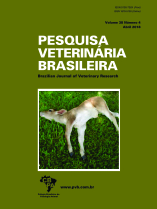 |
|
|
|
Year 2018 - Volume 38, Number 4
|

|
Antibiotic susceptibility of bacteria isolated from different types of ulcerative keratitis of dogs in the city of Cuiabá, Brazil, 38(4):726-733
|
ABSTRAT.- Monteiro G.B., Ruiz T., Schroder D.C., Silveira M.M., Dower N.M.B., Kagueyama F., Dutra V. & Ribeiro A.P. 2018. [Antibiotic susceptibility of bacteria isolated from different types of ulcerative keratitis of dogs in the city of Cuiabá, Brazil.] Susceptibilidade antibiótica de isolados bacterianos em diferentes tipos de ceratites ulcerativas de cães na cidade de Cuiabá. Pesquisa Veterinária Brasileira 38(4):726-733. Faculdade de Medicina Veterinária, Universidade Federal de Mato Grosso, Av. Fernando Corrêa da Costa 2367, Boa Esperança, Cuiabá, MT 78060-900, Brazil. E-mail: alexandre.aleribs@gmail.com
The purpose of the present study was to analyze antibiotic susceptibility of bacteria associated with different types of ulcerative keratitis in dogs. The outcome of medical or surgical treatment was also correlated with the type of isolate. Samples for microbiology were obtained by means of sterile swab from 104 eyes of 72 canine patients with ulcerative keratitis without previous history of antibiotic treatment, seen from May 2012 to March 2015. Only patients with no previous treatment with antibiotics were included in the study. Bacterial isolates were identified and the antibiotic susceptibility was tested to neomycin, gentamicin, tobramycin, chloramphenicol, polymyxin B, ciprofloxacin, ofloxacin and moxifloxacin. In total, 131 species of bacteria were isolated from 96/104 eyes, and Staphylococcus sp. predominated (48.09%), followed by Pseudomonas aeruginosa (16.01%). Shih Tzus were over represented (33.33%) and the number of gram-negative isolates were significantly higher in this breed, in comparison to Pinchers (P=0.003), Filas, Poodles, and other mixed-breeds (P=0.046). All species isolated in this study were more sensitive to ofloxacin (84.55%), that was significantly most efficient than neomycin and polymyxin B (P<0.0001), chloramphenicol (P=0.0001), tobramycin (P=0.0007), gentamicin (P=0.0021) and the other fluoroquinolones, ciprofloxacin (P=0.0004) and moxifloxacin (P<0.0001). Gram-positive organisms were isolated in a significant larger number of eyes with uncomplicated ulcerative keratitis, in comparison to those eyes with complicated ulcerative keratitis (P=0.011). Likewise, gram-positive were isolated in a larger number than gram-negatives microorganisms in cases that received either medically or surgical treatment, without statistical significance (P=0.745). In the present research, Staphylococcus sp. was the bacteria most commonly isolated in the eyes with uncomplicated ulcerative keratitis. Although Pseudomonas aeruginosa was the most common isolate in the eyes with complicated ulcerative keratitis, the majority of cases managed clinically had a successful outcome. Ofloxacin and gentamicin were found to be effective against the majority of isolates, with the exception of Streptococcus. sp, in which chloramphenicol was the most effective antibiotic. Uncomplicated ulcerative keratitis presenting negative culture may evolve to complicated ulcerative keratitis, warring the necessity of anti-collagenolytic treatment in all cases. |
| |
|
|
| |
|
 |